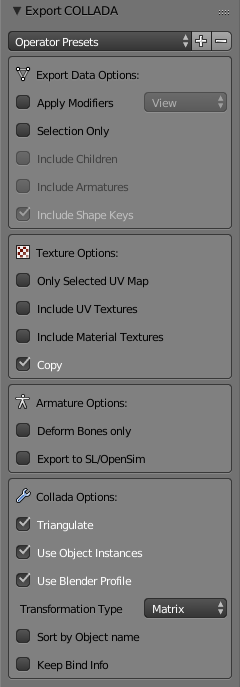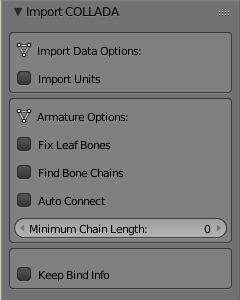Collada
The COLLADA™ module has been implemented as a flexible tool for exporting and importing .dae files.
A design goal is to provide a set of parameters which should make it possible
to export/import Collada files from/to a variety of tools.
But please be aware that the Collada module is still a work in progress.
So it may be possible that your particular usage scenario is not yet supported.
Trình Xuất Khẩu Collada (Collada Exporter)

Sắp Đặt Sẵn của Thao Tác (Operator Presets)
There are two operator presets (see top of the Sidebar) for Second Life (SL) users:
Second Life Static -- is good for exporting static meshes.
Second Life Rigged -- is good for exporting the SL default character.
Ghi chú
Special Notes for Second Life users:
Please use the Operator presets. All other export settings will not work for Second Life.
The character orientation needs to be such that the character looks towards positive X.
Scale and Rotation must be applied before the export!
Chính (Main)
- Duy Lựa Chọn (Selection Only)
When Selection Only is enabled, then only the selected objects will be exported. Otherwise the entire scene is exported with all visible and all invisible objects.
- Bao Gồm Con Cái (Include Children)
When this option is enabled then all children of the selected objects will also be exported regardless of their selection state.
Gợi ý
You can select only an armature, then using this option, all rigged meshes attached to the armature will also be exported.
- Bao Gồm Khung Cốt (Include Armatures)
When this option is enabled, then all armatures related to the selected objects will also be exported regardless of their selection state.
Gợi ý
You can select only the objects, then in the exporter enable this option to export the armature data also.
- Bao Gồm Hình Mẫu (Include Shape Keys)
Includes the application of shape keys by exporting meshes with the current shape key configuration baked in.
Định Hướng Toàn Cầu (Global Orientation)
Nội Dung Cần Viết Thêm.
Các Tùy Chọn về Chất Liệu (Texture Options)
- Duy Ánh Xạ UV được Chọn (Only Selected UV Map)
When your mesh contains multiple UV layers, then Blender exports all layers by default. This option allows you to only export the active (selected) UV layer.
- Sao Chép (Copy)
When you export images either material based image textures, then the exporter creates absolute file references in the export file.
But if the Copy option is enabled, the exporter will create copies of the images instead and place the copies besides the export file. In that case the file references are made relative.
Hình Học (Geometry)
Các Tùy Chọn về Xuất Khẩu Dữ Liệu (Export Data Options)
- Tam Giác Hóa (Triangulate)
The mesh can be triangulated on-the-fly. The triangulation is based on the same function which is used in the Triangulate Faces tool for triangulating the current selection of faces. For full control over the triangulation you can do this manually before exporting. However, this option allows to apply the triangulation only on the exported data; the mesh itself is not affected.
- Áp Dụng Bộ Điều Chỉnh (Apply Modifiers)
Export objects using the evaluated mesh, meaning the resulting mesh after all Modifiers have been calculated.
- Độ Phân Giải (Resolution)
Controls whether to apply the 3D Viewport resolution or the render resolution for modifiers that provide a preview mode and a render mode.
- Transform (Biến Hóa)
Collada supports two types of transformation matrix specifications. Either as
<Matrix>or as a set of transformation decompositions (for move, rotate and scale). Note that the exporter will not strictly follow this option setting, but will rather take it as a hint to use the option if ever possible. This is so because some of the exported data types have specific rules about how the transformation matrix has to be exported. This is ongoing development and a less ambiguous method may be provided in the future.
Armature (Khung Cốt)
Các Tùy Chọn về Khung Cốt (Armature Options)
- Duy các Xương Biến Dạng (Deform Bones Only)
When this option is enabled, then the exporter strips all non-deforming bones from the exported armatures. This option is useful when your armatures contain control bones which are not actually part of the character skeleton. For example you can export the Avastar rig with this option enabled. The resulting exported rig is compatible with Second Life. But please note the restrictions further below.
- Xuất Khẩu cho Sl/OpenSim (Export to SL/OpenSim)
When this option is enabled, some issues with bone orientation are calculated differently and is designed to be used to export to Second Life or OpenSim.
This is only relevant for rigged meshes, for static meshes it just does nothing at all.
Animation (Hoạt Họa)
Bổ Sung (Extra)
Các Tùy Chọn về Collada (Collada Options)
- Sử Dụng các Thực Thể của Đối Tượng (Use Object Instances)
In Blender you can reuse the same mesh for multiple objects. This is named "object instantiation". When you enable this option, then Blender will propagate object instantiation to the Collada file.
- Sử Dụng Sắp Đặt của Blender (Use Blender Profile)
Collada can be extended with tool specific data (profiles). Blender has its own (unofficial) profile that allows to export rig information into the Collada file. Later It can be used to reconstruct the rig when it should ever be necessary to import a dae file back into Blender.
- Sắp thứ tự theo tên của Đối Tượng (Sort by Object Name)
The export order of data is bound to internal object order and it can not be influenced in a reliable way. This option ensures that the Geometry nodes and the Object nodes are both exported in alphabetical order.
- Lưu Giữ Thông Tin Kết Buộc (Keep Bind Info)
When a rig is imported to Blender, the rig's bind pose will be used as Blender's rest pose. So all Matrix information of the original rest pose is lost. But in some cases you may want to preserve the original rig information. This option checks each bone for having two arrays:
rest_mat-- an array of 16 floats which represent the bone's original rest-pose matrix.bind_mat-- an array of 16 floats which represent the bone's original bind-pose matrix.
If the arrays are present, then those arrays will be used instead of the current rest pose/bind pose. Those two arrays are either created by a previous Collada import (see Collada Importer below), or they can be created manually, or by an add-on (script based).
Trình Nhập Khẩu Collada (Collada Importer)

The Collada importer is mostly driven by the imported data. There is one option for controlling the import units:
Các Tùy Chọn về Nhập Khẩu Dữ Liệu (Import Data Options)
- Pháp Tuyến Tùy Chỉnh (Custom Normals)
Use the mesh normals defined in the collada file, if they are defined, otherwise Blender will recompute them during the import process.
- Nhập Khẩu Đơn Vị (Import Units)
If not enabled the imported data will be rescaled according to the currently used unit system. If this option is enabled, then Blender will adjust itself to the unit system as provided by the Collada file.
Các Tùy Chọn về Khung Cốt (Armature Options)
- Sửa Xương Ngọn (Fix Leaf Bones)
Collada only records "joints" which is mostly similar to Blender's bone heads. But when you import a Collada file then the bone head/tail are not defined. This does not matter for connected bones where the bone parent only has one child. In that case the parent bone's end location is adjusted to the child's joint position. But especially for unconnected bones and for bones with more than one child a problem arises.
When the Fix Leaf Bones option is enabled then Blender tries to guess where the bone head/tail of unconnected bones would best be placed. If the option is disabled, then the bone head/tail are placed at an offset along the Y axis. That is why bones often point towards the Y axis.
- Tìm các Dây Chuyền Xương (Find Bone Chains)
When a bone has multiple children, then it is not defined which (if any) of the children should be connected to the bone. When the Find Bone Chains option is enabled, then Blender determines the longest bone chain (of children) for each bone. All bones along this chain will then be auto connected.
If the option is disabled, then children will only be connected to parents, if the parent has only one child. But see the Auto Connect option below.
- Tự Động Kết Nối (Auto Connect)
When this option is enabled, then children will automatically be connected to their parents, if the parent has only one child.
- Lưu Giữ Thông Tin Kết Buộc (Keep Bind Info)
When this option is enabled, then the importer creates two custom properties for each bone:
rest_mat-- an array of 16 floats which represent the bone's original rest-pose matrix.bind_mat-- an array of 16 floats which represent the bone's original bind-pose matrix.
Those two arrays can later be used when you want to export the rig again and be sure the original rest pose/bind pose combination must be used.
Chi Tiết Kỹ Thuật (Technical Details)
Mesh (Khung Lưới)
Nhập Khẩu (Import)
Supported geometry types are:
Tris (not tested)
Danh Sách đa giác
Đa Giác
Đa Giác (N-gons)
Tri-fans (not tested)
Số/các Đường/Dòng (Lines)
Xuất Khẩu (Export)
Mesh data is exported as <polylist>, <lines> and <vertices>.
Nguồn/Ánh Sáng/Đèn (Light)
Nhập Khẩu (Import)
Blender does a best effort on importing lights from a dae-file.
If a Blender profile is detected for lights, all values from these will be used instead.
This ensures full re-import from a Blender exported dae-file. <extra> support has been added in Blender 2.57.
Xuất Khẩu (Export)
A Blender profile for lights has been added through the <extra> tag.
The entire Light struct from Blender will be exported through this profile,
with the exception of light curve falloff.
Animation (Hoạt Họa)
Xuất Khẩu & Nhập Khẩu (Export & Import)
Support for object (mesh, camera, light) transform animations. Only Euler rotations, which is the default option for Objects, can be exported. For armature bone animations, Euler and quaternion rotation types are supported.
Import and export of animations for the following parameters are supported:
Nguồn/Ánh Sáng/Đèn (Light)
Máy Quay Phim (Camera)
Sắp Đặt về Nguyên Vật Liệu
Non-skin controlling armature bone animation.
Animations of armatures with skin deforming bones.
Animations of armatures in Object Mode.
Fully rigified armature animations (referring to the Rigify add-on). For export of rigified armature animations:
Run the Nướng Hành Động (Bake Action) operator.
If you have only the deform bones selected check Only Selected. This will give smaller dae. Otherwise uncheck Only Selected.
Xóa cá"Xóa Ràng Buộc" Tượng.
Nướng Hành Động.
Select the mesh and the deform bones. Then export to Collada while checking only selected option. (Selecting only the Mesh and bones is not strictly necessary. Selecting and export only selected will give smaller dae.)
For bone nodes which are leaf nodes in the armature tree,
or if a bone has more than one child, a Blender profile for tip with an <extra> tag,
is added for those joint nodes. To correctly derive the bone-to-tail location on re-import.
Ghi chú
Important Things to Remember
Object and data-block names are constrained to 21 characters (bytes).
UV layer names are constrained to 32 characters (bytes).
Only armature animation on mesh, single skin controller.
No support for modifiers yet.
When importing a dae-file that has <instance_node> on exporting
this information is essentially lost and these nodes will be <node>s.